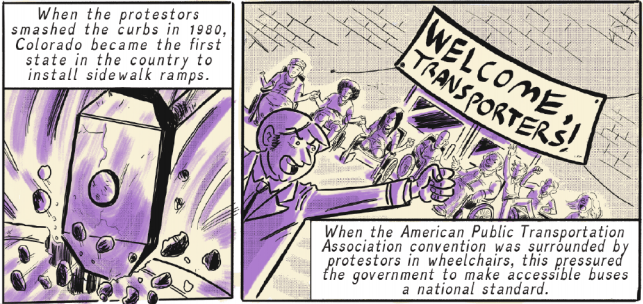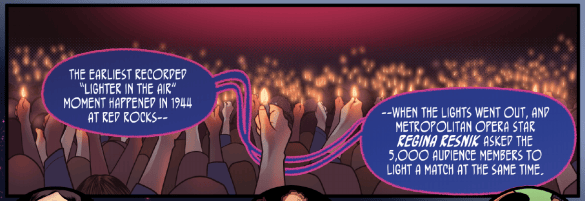
A new two-page comic starts with highlights of the story of the Gang of Nineteen, a group of protesters who forced the Regional Transportation District to add lifts to their buses, making them accessible to riders in wheelchairs.
"When the protestors smashed the curbs in 1980," the comic continues, "Colorado became the first state in the country to install sidewalk ramps."
The free comic download comes with a teacher guide, discussion questions, early versions of the artwork and historical reference photos -- it's a pretty cool package of stuff assembled by Colorful History, a program from local nonprofit Pop Culture Classroom.
(You might know them from one of their other programs, Denver Comic Con.)
Illya Kowalchuk, director of education at PCC, says the comics always focus on some piece of Colorado history, and that they often are stories that had a national impact or things that might be nationally known.
"We've all fallen in love with the Red Rocks issue. Dailen (Ogden)'s art is just so magical for that," he says. "Everybody has a Red Rocks story."
The first issue focused on Boulder-native astronaut Scott Carpenter. The third highlighted Chicano leader Rodolfo "Corky" Gonzales. The 14th, which Kowalchuk says continues to get a lot of downloads because it fits well into the fourth-grade curriculum, is about the Colorado state flag.
Issue No. 31, about the Disability Rights Movement, was written by Matthew K. Manning and illustrated by Denver artist Zak Kinsella.
"I was really proud to work on something that means a lot," Kinsella says. It's his second time working with Colorful History, and he says he's pitched more stories to the creative team at PCC.
"When we first started producing the stories, we wanted to create some kind of Sunday-like comics from years ago when they were given a lot more real estate in the newspapers and make them free to read," Kowalchuk says.

Kowalchuk says the comics are popular with teachers because they support history education, which PCC found was underserved relative to other subjects.
"A lot of teachers understand the value of comics," he says, "but it's cost prohibitive or it's a little intimidating. They don't know where to start."
Teachers have told the organization that the comics sometimes help get boys in particular to read, but that boys and girls alike enjoy them.
Kowalchuk also says, though, that the comics aren't just for school kids. The folks at PCC try to time their editorial calendar to anniversaries or other events that help emphasize the relevance of the history. They're working ahead, for example, on a story about Colorado Governor Ralph Carr, who spoke out against Japanese internment during World War II, even as Colorado itself was home to what was called the "Granada War Relocation Center."
"The specific audience is anybody who's interested in the comics," he says.
Kinsella agrees.
"Whenever I read these," he says, "it's just like dipping your toe in the water and it makes me want to go find out more."

His previous contribution to the series was art for an issue on Hattie McDaniel, the first African-America Academy Award winner. That issue has Kinsella and writer R. Alan Brooks thinking about producing a full graphic novel about McDaniel.
Colorful History publishes every other week.












